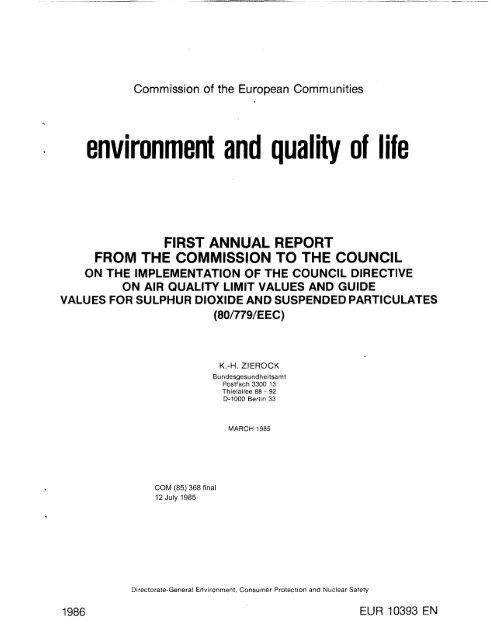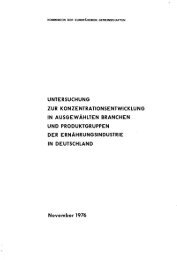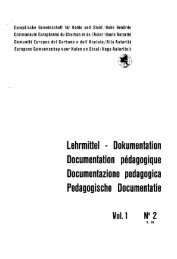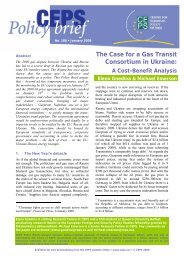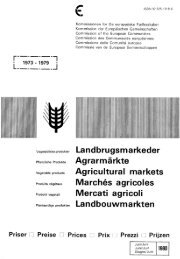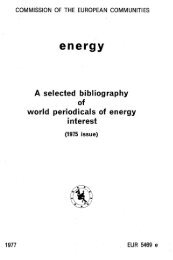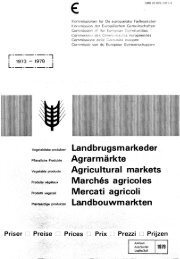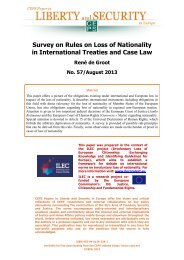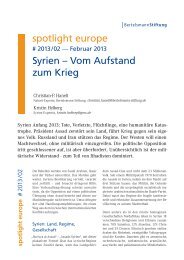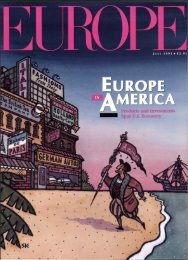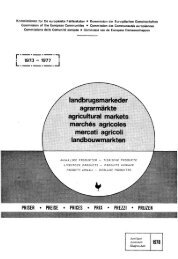Download (1731Kb)
Download (1731Kb)
Download (1731Kb)
Create successful ePaper yourself
Turn your PDF publications into a flip-book with our unique Google optimized e-Paper software.
Commission of the European Communities<br />
environment and quality of life<br />
FIRST ANNUAL REPORT<br />
FROM THE COMMISSION TO THE COUNCIL<br />
ON THE IMPLEMENTATION OF THE COUNCIL DIRECTIVE<br />
ON AIR QUALITY LIMIT VALUES AND GUIDE<br />
VALUES FOR SULPHUR DIOXIDE AND SUSPENDED PARTICULATES<br />
(80/779/EEC)<br />
1986<br />
K.-H. ZIEROCK<br />
Bundesgesundheitsamt<br />
Postfach 3300 13<br />
Thielallee 88 - 92<br />
D-1000 Berlin 33<br />
MARCH 1985<br />
Directorate-General Environment, Consumer Protection and Nuclear Safety<br />
EUR 10393 EN
Published by the<br />
COMMISSION OF THE EUROPEAN COMMUNITIES<br />
Directorate-General<br />
Telecommunications, Information Industries and Innovation<br />
Batiment Jean Monnet<br />
LUXEMBOURG<br />
LEGAL NOTICE<br />
Neither the Commission of the European Communities nor any person acting on behalf<br />
of the Commission is responsible for the use which might be made of the following<br />
information<br />
© ECSC -- EEC - EAEC, Brussels-luxembourg. 1986
III<br />
ABSTRACT<br />
Efforts to combat pollution will not be successful unless environmental<br />
policy measures are taken at international level. The EEC Council Direc<br />
tive of 15 July 1980 on air quality limit values and guide values for<br />
sulphur dioxide and suspended particulates is just one stepping-stone on<br />
the path towards an international clean air policy.<br />
The first annual report on the implementation of the Directive shows quite<br />
plainly, however, that environment policy is not so much a joint effort by<br />
"all those concerned" to locate islands of consensus in a sea of practical<br />
constraints, but rather a constant tussle with vested interests. The<br />
degree to which policy objectives aimed at ridding the air of harmful<br />
pollutants can be achieved depends largely on social awareness of environ<br />
mental problems, economic and technical factors (preventive measures) and<br />
on the pattern and availability of energy resources.<br />
All these factors play a crucial role in the implementation of the Direc<br />
tive but there are major differences in the problems confronting each<br />
Member State and in the approaches they adopt to put it into practice.<br />
As a consequence, the implementation of the Directive is beset with major<br />
difficulties and the progress made so far is anything but satisfactory.<br />
As the Commission views the Directive as an acid test of the Member<br />
States' commitment to environment policy, it will continue to spare no<br />
effort in ensuring proper and uniform implementation of the Directive.
PREFACE<br />
I. Introduction<br />
v<br />
CONTENTS<br />
II. Legal implementation of the Directive<br />
III. Application of the Directive<br />
1. Monitoring of the pollutants.<br />
1 . 1 . National bodies responsible for monitoring<br />
1 . 2. Ana lyti cal methods, instrumentation and data<br />
presentation<br />
1. 3. Network design<br />
2. Information received in accordance with article 3.<br />
3. Information received in accordance with article 7. 33<br />
4. Assessment of the present ambient air situation. 42<br />
IV. Annex IV problem 48<br />
1. General aspects 48<br />
2. Results of parallel measurements 52<br />
3. Assessment of the problem. 53<br />
V. Common Measurement Programme (CMP> 54<br />
1. Background 54<br />
2. Aims of the Common Measurement Programme 55<br />
3. Initial results 57<br />
VI. Adaptation of the reference methods 58<br />
VII. Acknowledgements 62<br />
page<br />
2<br />
2<br />
5<br />
5<br />
5<br />
6<br />
22<br />
23
- 3 -<br />
- Alkali etc. Works
- 5 -<br />
Luxembourg has informed the Commission, by Letters of 12 May 1981 and<br />
10 August 1982, that the existing Luxembourg Legislation assured<br />
compliance with the provisions of the Directive, so that no specific<br />
Legislation needed be enacted.<br />
At present discussions are being pursued between the Commission and<br />
the Luxembourg authorities as to the interpretation of the Directive.<br />
Ireland observed, by Letters of 26 January 1983 and 5 January 1984,<br />
that it considered the objectives of the directive 80/779 were already<br />
covered by the existant Irish Legislation and that no further<br />
statutory rules were required.<br />
The Commission has Launched an official procedure against Ireland<br />
under Article 169 of the Treaty of Rome.<br />
The Netherlands has, by Letters of 8 April 1981, 1 September 1982, 2<br />
December 1982 and 5 September 1983 informed the Commission of their<br />
national measures to implement Directive 80/779 and a Bill to amend<br />
the Wet inzake de Luchtverontreiniging.<br />
The Commission has started an infringement procedure against the<br />
Netherlands under Article 169 of the Treaty of Rome.<br />
III. Application of the Directive<br />
III.1. Monitoring of the pollutants<br />
III.1.1. National Bodies responsible for monitoring<br />
ALL Member States of the EC monitor the quality of air and the<br />
national and/or regional bodies responsible are given in Table 1.<br />
Nearly all of them regularly publish the concentrations measured.<br />
·---·-----
- 6 -<br />
111.1.2. Analytical methods, instrumentation and data presentation<br />
Article 10(1) requires that Member States demonstrate to the<br />
Commission either a satisfactory correlation or a reasonably stably<br />
relationship, between national methods and the reference methods in<br />
the Directive.<br />
From an inventory compiled by the Commission in 1982 , Member States<br />
are running, within the framework of this Directive, in total<br />
- 1947 so2 monitors<br />
- 1200 Black smoke monitors<br />
- 242 gravimetric SPM monitors.<br />
The type of instruments or analytical methods used in Member States<br />
are shown in Tables 2 and 3.<br />
From this inventory it can be concluded that<br />
1. so 2 , black smoke and/or suspended particulates are monitored by all<br />
Member States. In most cases so 2 is monitored more frequently than<br />
black smoke and/or suspended particulates.<br />
2. The measurements are carried out with several different methods or<br />
instruments. At present Little can be said about the comparability<br />
of these different methods because performance tests and/or<br />
parallel measurements have not been carried out according to<br />
internationally agreed and comparable rules. Only the F.R. Germany<br />
has published test procedures and performances characteristics 2<br />
which provide a national basis for such comparability checks. On<br />
the basis of these checks 3 so 2 -instrurr,ents (Thermo Electron/van<br />
Hengel - Mod. 43; Wusthoff oHG, BO - Ultragas U3ES; Hartmann &<br />
Braun, F - Picoflux 4) and 2 instruments for the gravimetric<br />
Final report on inventory of current measuring techniques for so 2 ,<br />
black smoke and suspended particulates. Document XI/27/83.<br />
2 Federal Office of the Environment of the F.R. Germany : Test routine<br />
for the performance testing of measuring devices for continuous<br />
monitoring of immissions (1982).
- 8 -<br />
Member States for informing the Commission of cases,<br />
with Article 7, where the Limit values are exceeded.<br />
in conformity
- 10 -<br />
Bayerisches Landesamt<br />
fur Umweltschutz<br />
Rosenkavaliersplatz 3<br />
D - 8000 Munchen 81<br />
Behorde fur Bezirksangelegenheiten,<br />
Naturschutz und Umweltgestaltung<br />
Steindamm 22<br />
D - 2000 Hamburg<br />
Hessische Landesanstalt fur Umwelt<br />
Aarstrasse 1<br />
D - 6200 Wiesbaden<br />
Senator fur Stadtentwicklung<br />
und Umweltschutz<br />
Lentzeallee 12-14<br />
D - 1000 Berlin 33<br />
Landesverwaltungsamt<br />
Niedersachsen<br />
Institut fur Arbeitsmedizin<br />
Immissions- und Strahlenschutz<br />
Davenstadter Str. 109<br />
D - 3000 Hannover-Linden<br />
Landesanstalt fur Immissionsschutz<br />
Nordrhein-Westfalen<br />
Wallneyer Str. 6<br />
D - 4300 Essen<br />
Landesgewerbeaufsichtsamt fur<br />
Rheinland-Pfalz<br />
Rheinallee 97 - 101<br />
D - 6500 Mainz
France<br />
- 11 -<br />
Staatliches Institut fur Hygiene<br />
und Infektionskrankheiten<br />
Malstatter Strasse 17<br />
D - 6600 Saarbrucken<br />
Ministere de L'Environnement<br />
Direction de La Prevention des<br />
Pollutions<br />
Service de L'Environnement Industriel<br />
Sous-Direction de La Pollution de L'Air<br />
14, Bd. du General Leclerc<br />
F- 92524 Neuilly-sur-Seine Cedex (*)<br />
Direction Regionale de L'Industrie et de<br />
La Recherche Ile de France<br />
152, rue de Picpus<br />
F - 75570 Paris Cedex 12<br />
Direction Regionale de L'Industrie et<br />
de La Recherche<br />
Delegation Champagne Ardennes<br />
2, rue Grenet Tellier<br />
F - 51038 Chalons sur Marne Cedex<br />
Direction Regionale de L'Industrie et<br />
de La Recherche Bourgogne<br />
Cite Administrative Dampierre<br />
6, rue Chancelier de L'H6pital<br />
F - 21034 Dijon Cedex<br />
Direction Regionale de L'Industrie et<br />
de La Recherche Auvergne<br />
43, rue de Wailly<br />
F - 63038 Clermont Ferrand Cedex
- 13 -<br />
Direction Regionale de L'Industrie et de<br />
La Recherche Rhone Alpes<br />
11, rue Curie<br />
F - 69456 Lyon Cedex 3<br />
Direction Regionale de L'Industrie et de<br />
La Recherche Provence Alpes Cote d'Azur<br />
37, Boulevard Perier<br />
F - 13295 Marseille Cedex 2<br />
Direction Regionale de L'Industrie et de La<br />
Recherche Aquitaine<br />
26, cours Xavier Arnozan<br />
F - 33076 Bordeaux Cedex<br />
Direction Regionale de l'Industrie et<br />
de La Recherche Poitou Charentes<br />
62, rue Jean Jaures<br />
F - 86000 Poitiers<br />
Direction Regionale de L'Industrie et<br />
de La Recherche Bretagne<br />
13, rue Dupont des Loges<br />
F - 35043 Rennes Cedex<br />
Direction Regionale de L'Industrie et de<br />
La Recherche Centre<br />
16, rue Adele Lanson Chenault B.P. 45<br />
F - 45655 Saint Jean Le Blanc Cedex<br />
Direction Regionale de L'Industrie et de<br />
La Recherche Basse Normandie<br />
Residence Helitas<br />
27, rue Saint-Ouen<br />
F - 14039 Caen cedex
Greece<br />
Ire Land<br />
- 14 -<br />
Direction RegionaLe de L'Industrie et<br />
de La Recherche Pays de La Loire<br />
CAP 44<br />
3, rue Marcel Sembat<br />
F - 44049 Nantes Cedex<br />
Direction Regionale de L'Industrie et de<br />
La Recherche<br />
Haute Normandie<br />
68-70, rampe Bouvreuil<br />
F - 76037 Rouen Cedex<br />
Ministry of Physical Planning,<br />
Housing and Environment<br />
Patissionstreet 147<br />
Athens 814 (*)<br />
Environment Pollution<br />
Control Project (P.E.R.P.A.)<br />
Patissionstreet 147<br />
Athens 814<br />
Laboratory of Hygiene, Medical Faculty<br />
University of Thessaloniki and State<br />
Laboratory of the Ministry for Northern<br />
Greece<br />
Department of Environment<br />
Custom House<br />
DubLin<br />
An Foras Forbartha<br />
St. Martin's House<br />
Waterloo Road<br />
Dublin 4 (*)
Italia<br />
- 15 -<br />
Reparto di Igiene dell'Aria<br />
dell'Istituto Superiore di Sanita<br />
Viale Regina Elena 299<br />
I - 00161 Roma (*)<br />
Laboratorio Chemica Provinciale<br />
Via Amba Alagi, 5<br />
I - 39100 Balzano<br />
Presidio Multizonale di Igiene<br />
e Prevenzione<br />
Corso Giovecca 169<br />
I - 44100 Ferrara<br />
Presidio Multizonale di Igiene<br />
e Prevenzione USL 8<br />
Via Baroni 18<br />
I - 51100 Pistoia<br />
Servizio Rilevamento<br />
Inquinamento Atmosferico<br />
Via della Consolata 10<br />
I- 10100 Torino<br />
Presidio Multizonale di Igiene<br />
e Prevenzione<br />
Vi a J uvara 22<br />
I- 20129 Milano<br />
Laboratorio di Igiene e Profilassi<br />
USL RM 10<br />
Via Saredo 52<br />
I - 00173 Roma
- 16 -<br />
Laboratorio di Igiene e Profilassi<br />
USL 12<br />
Via Montesano 5<br />
I - 16122 Genova<br />
Servizio Rilevamento Inquinamento<br />
Atmosferico<br />
Laboratorio di Igiene e Profilassi USL 28<br />
Via Triachini 17<br />
I - 40138 Bologna<br />
Laboratorio di Igiene e Profilassi<br />
Via Ospedale 22<br />
I - 35100 Padova<br />
Laboratorio di Igiene e Profilassi<br />
Via Basardecci 5<br />
I - 96100 Stracusa<br />
Laboratorio di Igiene e Profilassi<br />
Viale Piave 5<br />
I - 38100 Trento<br />
Laboratorio di Igiene e Profilassi<br />
Via Patriota 2<br />
I - 54100 Massa<br />
Servizio Controllo Inquinamento Ambientale<br />
Via s. Maria La Nova<br />
I - 80139 Napoli<br />
Laboratorio Igiene e Profilassi<br />
Via Anfiteatro<br />
I - 74100 Taranto<br />
Laboratorio Igiene e Profilassi USL 10/4<br />
Via Ponte delle mosse 211<br />
I - 50144 Firenze
- 17 -<br />
Presidio Multizonale di Igiene e Profilassi<br />
Via Fontanel l i 21<br />
I - 41100 Modena<br />
Laboratorio Igiene e Profilassi<br />
Via Miglietta<br />
I - Leece<br />
Administrazione Provinciale di Venezia<br />
PaLazzo Corner<br />
I - 30124 Venezia<br />
Grand-Duche du Luxemboarg Administration de<br />
Nederland<br />
United Kingdom<br />
L'Environnement<br />
A, rue A. Lumiere<br />
L - 1950 Luxembourg (*)<br />
Rijksinstituut voor Volks<br />
gezondheid en Milieuhygiene<br />
Laboratorium voor Luchtonderzoek<br />
Postbus 1<br />
Ant. van Leeuwenhoeklaan 9<br />
3720 BA Bilthoven (*)<br />
Warren Spring Laboratory<br />
Gunnels Wood Road<br />
UK - Stevenage, Herts SG1 2BX (*)
Table 3 Number of different types of instruments as notified by the Member States for so - and SPM-survey for complying with<br />
2<br />
Directive 80/779/EEC<br />
so 2<br />
Black smoke<br />
continuous 619<br />
- FPD 133<br />
- Cond. 107<br />
- UV-F 76<br />
- Coul. 303<br />
non-continous 1 328<br />
according to OECD<br />
- strong acidity 1 299<br />
( 1)<br />
- other methods 29 Total : 1 947<br />
1 181<br />
other methods 19 Total : 1 200<br />
Suspended particulates<br />
by weighing 155<br />
other methods 87 TotaL : 242<br />
(1) KOH impregnated filters (DK) 24; TCM-instruments (GR) 5<br />
Abreviations :<br />
FPD - Flame photometric method<br />
Cond = Conductimetric method<br />
UV-F = UV-Fluorescence method<br />
Coul = Coulometric method<br />
18 different types of instruments<br />
4 different types of instruments<br />
3 different types of instruments<br />
7 different types of instruments _.<br />
1 instrument type<br />
7 different types of instruments<br />
1 instrument type<br />
-..()
Table 4<br />
Netherlands<br />
Ire Land<br />
Denmark<br />
- 20 -<br />
List of authorized Laboratories nominated by Member States<br />
for the testing of measurement equipment in the framework<br />
of Directive 80/779/EEC.<br />
RIVM<br />
Mr. H.J. van de Wiel<br />
A.van Leeuwenhoeklaan 9<br />
P.O. Box 1<br />
NL- 3720 BA Bilthoven<br />
MT-TNO<br />
Mr. J.C.T. Hollander<br />
Schoemakerstraat 92<br />
P. 0. Box 214<br />
NL- 2600 AE Delft<br />
National Institute for Physical<br />
Planning and Construction Research<br />
(AN FORAS FORBARTHA)<br />
St. Martin's House<br />
Waterloo Road<br />
Dublin 4<br />
Riso National Laboratory<br />
Air Pollution Lab<br />
National Agency of environmental<br />
protection<br />
DK- 4000 Roskilde
Belgium<br />
United Kingdom<br />
F.R. Germany<br />
- 21 -<br />
Institut d'Hygiene et d'Epidemiologie<br />
14, rue Juliette Wytsman<br />
8 - 1050 Bruxelles<br />
Warren Spring Laboratory<br />
Department of Industry<br />
Gunnels Wood Road<br />
UK - Stevenage, Herts, SG1 2BX<br />
Umweltbundesamt<br />
Pilotstation Frankfurt<br />
D - Frankfurt<br />
Landesanstalt fur Immissionsschutz<br />
des Landes Nordrhein-Westfalen<br />
D - Essen-Bredeney<br />
Landesanstalt fur Umweltschutz<br />
Baden-Wurttemberg<br />
D - Karlsruhe
- 23 -<br />
III.2. Information received in accordance with article 3<br />
Article 3 of the Directive states, inter alia, that each Member State<br />
"where it considers that there is a Likelihood that, despite the<br />
measures taken, the concentrations of sulphur dioxide and suspended<br />
particulates in the atmosphere might, after 1 ApriL 1983, exceed in<br />
certain zones the Limit values given in Annex I, it shall inform the<br />
Commission thereof before 1 October 1982".<br />
Belgium, Denmark and Greece have not notified any zone within this<br />
requirement.<br />
The other Member States have notified the Commission that the Limit<br />
values are Likely to be approached or exceeded in the zones Listed in<br />
Table 5.<br />
Table 5 ZONES IN THE MEMBER STATES OF THE EUROPEAN COMMUNITY IN<br />
WHICH THE LIMIT VALUES FOR so 2 AND SUSPENDED PARTICULATES<br />
OF DIRECTIVE 80/779/EEC ARE LIKELY TO BE APPROACHED OR<br />
EXCEEDED AFTER THE 1ST APRIL 1983 6<br />
Member States Zones<br />
FRANCE Agglomeration parisienne, Lens, Dunkerque,<br />
agglomeration de Creil, Carling, agglomeration!<br />
de Strasbourg, Thann, agglomeration de Mont<br />
beliard, agglomeration Lyonnaise, agglomera<br />
tion grenobloise, region de Fos l'Etang-de<br />
Berre, agglomeration marseillaise, Viviez,<br />
Lacq, zone de Chevire-Donges, agglomeration<br />
rouennaise, zone du Havre<br />
6 The basis of this List is the information provided by the Member<br />
States up to 30.9.1983.
F.R.G.<br />
IRELAND<br />
ITALY<br />
LUXEMBOURG<br />
UNITED KINGDOM<br />
Be r L i n (West )<br />
Dublin<br />
Regione Veneto<br />
- 24 -<br />
Arzignano-Bassano del Grappa-Belluno-Castel<br />
franco-Veneto-Chioggia-Conegliano-Legnago<br />
Mira-Montecchio-Maggiore-Padova-Porto Tolle<br />
Rovigno S.Dona di PiaveShio-Treviso-Valdagno<br />
Venezia-Verona-Vicenza-Vittorio Veneto.<br />
Regione Lombardia<br />
Abbiategrasso-Arcore-Bareggio-Biassono-Bollatel<br />
Bovisio M.-Bresso-Brugherio-Busto Garolfo<br />
Canegrate-Cassano d'Adda-Cernusco SIN-Cerro<br />
Maggiore-Cesano-Maderno-Cesate-Cinisello<br />
Balsamo-Cologno M.-Concorezzo-Corbetta-Cormanol<br />
Coraredo-Cornate d'Adda-Cuggiono-Cusano M.<br />
Desio-Carbagnate-Gorgonzola-Inveruno-Lainate<br />
Legnano-Limbiate-Lissone-Lodi-Magenta-Meda<br />
Melgnao-Melzo-Milano-Monza-Moggio-Nerviano<br />
Nova- Milanese-Novate Milanese-Paderno D.<br />
Parabiago-Pioltello-Rescaldina-Rho-Rozzano<br />
S.Giuliano M.-Segrate-Senago-Seregno-Sesto<br />
S.Gt-Seveso-Solaro-Tribiano-Veduggio-Vimodronel<br />
Vittuone.<br />
Colmar-Berg, Contern<br />
Allerdale, Barnsley, Bassetlan, Blyth Valley,<br />
Bolsover, Bradford, Cannock Chase, Chester<br />
field, Copeland, Crewe and Nantwich, Doncaster!
I<br />
1 Zone du Havre I Improvement in 1985 of the already existing alert procedures on the basis of I<br />
1 I "Reglementation sur les installations classees". I<br />
I I I I<br />
! I I I<br />
I<br />
1 F.R. I Berlin (West) I Reduction of emissions from industrial and domestic sources. Preparation for negotiations I<br />
1 Germany I I with the GDR in order to reduce transboundary fluxes into Berlin (West) which account for I<br />
1 1 I up to 40% of the so 2 -ambient air concentrations. I<br />
i I I I<br />
1 Ireland I Dublin I Investigations into the reasons are underway, including the application of mathematical I<br />
1 I I modeLs. I<br />
I I I I<br />
j ItaLy I i No communication about counter measures has been submitted to the Commission. I<br />
I I I I<br />
1 Luxembourg I Colmar-Berg I Technical modifications on plants are being implemented in order to decrease emission I<br />
1 I I from industrial and electricity-producing sources. I w<br />
I I IN<br />
I Contern I Studies on possible counter measures aiming at a reduction of emissions from industrial I<br />
I I I sources are under way. I<br />
I I I I<br />
1 United I I No detailed information has been submitted to the Commission concerning the other areas I<br />
I Kingdom I I mentioned in Table 5. I<br />
I I I I
Table 9<br />
Counter measures planned or underway in order to avoid the recurrence of instances in which the limit values have been<br />
exceeded<br />
-1<br />
Member I Zone I Counter measure<br />
State I I I<br />
I I I<br />
France I Vitry-sur-Seine I Study on further emission reductions underway. I<br />
I I I<br />
I Saint-Saulve I Measures to reduce industrial emissions underway. 'I<br />
I I I<br />
I Agglomeration de I Study on alert systems underway. I<br />
I Strasbourg I I<br />
I I I<br />
I I I<br />
I Bouc Bel Air I Implementation of an alert system. I I<br />
I I I""'<br />
I Zone de Lillebonne- I Study on further emission reductions underway. I I<br />
I Gravenchon-Qui Llebeufl I<br />
I I I<br />
I Le Havre I Improvement of existing alert system planned. I<br />
I I I
- 42 -<br />
The Italian delegation indicated that no report could be submitted due<br />
to problems of internal responsibility. The Danish delegation<br />
explained that no report has been submitted because no violations of<br />
the Limit values set out in the Annexes were detected in the reference<br />
period. The German delegation mentioned that a second report had been<br />
sent by UBA to the BMI in October 1984 and that the Commission should<br />
receive this report very soon.<br />
The Commission emphasized that Member States are obliged to report in<br />
due time in accordance with article 10(3) and that they have to report<br />
even when no exceedances occurred. The three Member States concerned<br />
were requested to send these reports to the Commission without further<br />
delay.<br />
Moreover, Article 7 states that Member States shall<br />
Commission, not<br />
reference period,<br />
Later than one year after<br />
the end of<br />
of the reasons for such instances<br />
measures they have taken to avoid their recurrence.<br />
notify the<br />
the annual<br />
and of the<br />
The Latest date for providing this information is therefore 30.9.1985.<br />
Up to now the Commission has only received information from<br />
Luxembourg, the United Kingdom and France<br />
Table 9 gives an overview about these actions.<br />
on the actions taken.<br />
Article 7(3) requires, that "Member States shall forward information<br />
to the Commission, at its request, on the concentrations of sulphur<br />
dioxide and suspended particulates in any zones they have designated<br />
pursuant to Article 4(1) and (2).<br />
However, up to now none of the Member States have used article 4 so<br />
that no information could be requested.<br />
III.4. Assessment of the present ambient air pollution Levels<br />
On the basis of the information provided by the Member States and of<br />
EC investigations a brief overview of the ambient air pollution Levels<br />
for so 2 , Black Smoke and gravimetrically measured suspended
- 43 -<br />
particulates will be given for each country. It would be beyond the<br />
scope of this report to give detailed tables of all measurements<br />
carried out within the frame of the Directive.<br />
Trend evaluations for so 2 , Black Smoke and suspended particulates show<br />
for all three compounds, a general decrease in values since 1970.<br />
However, in the cases the decrease stopped in the early 80's and the<br />
situation seems to be quite stable over the Last four years. The cold<br />
spell in January 1985 will most Likely cause an increase in the<br />
measured concentrations for the reference period 1984/85 in some<br />
Member States.<br />
It should be noted that Article 5 of the Directive requires that<br />
Member States shall endeavour to move towards the guide values of<br />
Annex II wherever the measured concentrations are higher than these<br />
values. In the Light of the data below it can be seen that zones<br />
exceeding these guide values exist in all Member States.<br />
Belgium<br />
The most pol Luted zones are Bruxel Les (Brussel), Anvers (Antwerpen),<br />
Liege (Luik), Charleroi and Gand (Gent). The measured annual<br />
concentrations are in the ranges of :<br />
annual averages<br />
so2 (24 h)<br />
Black Smoke<br />
winter averages<br />
so2 (24 h)<br />
Black Smoke<br />
Denmark<br />
20<br />
10<br />
30<br />
15<br />
50%<br />
90<br />
so<br />
120<br />
70<br />
80<br />
30<br />
100<br />
Measurement from only very few stations are available.<br />
50<br />
98%<br />
300 ug/m 3<br />
70 ug/m 3<br />
350 ug/m 3<br />
100 ug/m 3<br />
The most<br />
polluted area is Kobenhavn where concentrations in the following<br />
ranges have been measured :
so 2
- 45 -<br />
The measured concentration ranges are<br />
Annual averages SO% 98%<br />
so2 30 90 80 260 ug/m<br />
3<br />
Black Smoke 15 50 30 120 ug/m 3<br />
Winter averages<br />
so2 30 120 90 350 ug/m<br />
3<br />
Black smoke 25 80 35 140 ug/m 3<br />
Greece<br />
Very Little is known about the air pollution Levels in Greece.<br />
However, the most polluted areas are probably Athens and Thessaloniki.<br />
Measured concentrations are in the ranges of<br />
AnnuaL ave rages 50%<br />
so 2<br />
Black Smoke<br />
Winter averages<br />
soz<br />
Black Smoke<br />
Ireland<br />
40 .• 60<br />
40 .. 60<br />
98%<br />
no data available<br />
no data available<br />
3<br />
80 .. 120 ug/m<br />
3<br />
80 .. 120 ug/m<br />
Except for Dublin, the urban areas of Cork, Dundalk, Drogheda and<br />
Limerick have relatively elevated pollution Levels.<br />
concentration Levels are in the range of :<br />
Measured
- 46 -<br />
Annual averages SO% 98%<br />
soz 20 90 60 240 ug/m 3<br />
Black Smoke 10 so 20 240 ug/m 3<br />
Winter averages<br />
soz 30 70 70 260 ug/m<br />
3<br />
Black Smoke 15 60 so 270 ug/m 3<br />
Due to the very sparse information, the Commission is unable to assess<br />
the ambient air situation in Italy. There are most Likely more<br />
polluted zones than those mentioned in Table 5, e.g. cities and areas<br />
in Piemonte, Liguria, Emilia Romagua, Toscana, Luzio, Campania,<br />
Sicilia.<br />
Measured concentrations in the pol Luted areas are estimated to be in<br />
the range of :<br />
AnnuaL ave rages SO% 98%<br />
soz (24 h)<br />
Suspended particulates<br />
so 160 150 350 ug/m 3<br />
. . ..<br />
arithmetic mean 95%<br />
60 160 100 200 ug/m 3<br />
. . ..<br />
Winter averages 50% 98%<br />
3<br />
soz (24 h) 80 .. 250 120 .. 650 ug/m
Luxembourg<br />
- 47 -<br />
The Commission does not know of any polluted area other than those<br />
Listed in Table 5. The concentration ranges measured are :<br />
Annual averages<br />
so2
- 48 -<br />
Iii<br />
Annual ave rages 50% 98%<br />
so 2<br />
50 100 100 240<br />
3<br />
ug/m<br />
Black Smoke 30 80 80 350 ug/m 3<br />
Winter averages<br />
so<br />
2<br />
60 120 no data available<br />
Black Smoke 50 150 no data available<br />
IV. Annex IV problem<br />
IV.1. General aspects<br />
According to articles 10(2) and 10(4) of the Directive it is said that<br />
"without prejudice to the provisions of this Directive, a Member State<br />
may also use, pending the decision of the Council on the proposals<br />
from the Commission referred to in paragraph 4, the sampling and<br />
analysis methods Laid down in Annex IV and the values associated with<br />
these methods also Laid down in Annex IV in substitution for the Limit<br />
vaLues set out in Annex I".<br />
"A Member State which decides to avaiL itself of the provisions of<br />
paragraph 2 must however take measurements in parallel at a series of<br />
representative measuring stations, chosen in accordance with the<br />
requirements of Article 6, in order to verify the corresponding<br />
stringency of the Limit values set out in Annex IV and Annex I. The<br />
results of these parallel measurements, including in particular<br />
instances in which the Limit values Laid down in Annex I have been<br />
exceeded and the concentrations recorded, shall be forwarded to the<br />
Commission at regular intervals, and at Least twice a year, for<br />
incorporation in the annual report provided for in Article 8".<br />
"The Commission shall, after five years, but within six years of the<br />
expiry of the Limit of 24 months specified in Article 15(1), submit a<br />
report to the Council on the results of the parallel measurements
- 49 -<br />
carried out under paragraph 3 and shall, having regard in particular<br />
to these results and to the need to avoid discriminatory provisions,<br />
make proposals relating to paragraph 2 and Annex IV". In the report<br />
provided for in Article 8 the Commission will indicate whether it has<br />
noted instances in which the limit values fixed in Annex I have been<br />
exceeded to a significant extent on repeated occasions.<br />
In practical terms this means that the Directive permits one of two<br />
systems of monitoring to be used to implement the Directive :<br />
(i) black smoke and sulphur dioxide fixed station networks (Annex I<br />
of the Directive)<br />
(ii) temporarily, until reviewed suspended particles at fixed<br />
stations and sulphur dioxide from random sampling networks<br />
(Annex IV).<br />
However, any Member State availing itself of the provisions of Article<br />
10.2 and, therefore, the second of the above two alternatives, must<br />
carry out parallel measurements at a series of measuring stations,<br />
selected in accordance with Article 6, to verify the corresponding<br />
stringency of the two approaches.<br />
Article 10.3.<br />
This requirement is set out in<br />
Two Member States, F.R. Germany and Denmark, are applying the Annex<br />
IV while Italy is applying for so 2 the limit values of Annex I and for<br />
suspended particulates the Limit values set out in Annex IV.<br />
Parallel measurements are being carried out in these three Member<br />
States, partly in cooperation with the Commission
- 50 -<br />
Moreover and particularly in order to accelerate the process of fact<br />
finding, in 1982 the Commission Launched a study on the assessment of<br />
the corresponding stringency of Annexes I and IV.<br />
experts concluded in the final report 7<br />
that :<br />
Inter alia, the<br />
1. The monitoring and assessment systems in Annex I and Annex IV are<br />
not directLy comparabLe because of fundamentaL differences in<br />
sampling for sulphur dioxide and in the methods of measurement for<br />
suspended particulates. For suspended particulates it must be<br />
stressed that there are two methods which measure essentially<br />
unrelated properties of the particulates : for black smoke (Annex<br />
I) it is a measure of the blackness (carbon content) of suspended<br />
particulates whilst for the gravimetric method (Annex IV) it is a<br />
measure of the mass, independently of colour or composition. It<br />
is concluded that the only practicable criterion for assessing<br />
corresponding stringency is the ratio of measured value Limit<br />
value. Unless the Annex I and Annex IV values of this ratio are<br />
equal the t11o systems are not equally stringent.<br />
2. The Annex I Limit values for sulphur dioxide are more stringent<br />
7<br />
than the Annex IV Limit values with the exception of the (upper)<br />
Long-term value which is permitted under the Annex I system when<br />
the associated black smoke concentrations are Low.<br />
Annex IV system of random sampling over an area<br />
However,<br />
of 16 km 2<br />
produce measured values of the statistics which are 10-40% Less<br />
than the values which would be measured at a station in the most<br />
polluted part of the 16 km 2 area. This can increase further the<br />
stringency of Annex I in comparison to Annex IV for sulphur<br />
dioxide and can mean that the upper Long-term Limit value of Annex<br />
I is also more stringent than the Annex IV Long-term value.<br />
Keddie, Lahmann, Mcinnes : European Community Directive 80/779/EEC :<br />
An assessment of monitoring network design and of the corresponding<br />
stringency of Annexes I and IV.<br />
Final report
- 51 -<br />
3. For suspended particles, in general throughout the Member States,<br />
the available evidence indicates that the Annex IV Limit values<br />
are more stringent than those of Annex I but there are Locations<br />
where the opposite can be the case. The main reason for this<br />
inconsistency is the fundamental difference between determining<br />
suspended particulate concentrations by the black smoke (Annex I)<br />
and gravimetric (Annex IV) methods. Any relationship between the<br />
two methods varies substantially from place to place and, even at<br />
the same Location, varies from day to day and, perhaps, from year<br />
to year. Therefore, it will usually be necessary to make separate<br />
measurements of both black smoke and gravimetric concentrations<br />
because one cannot be deduced from the other with sufficient<br />
reliability.<br />
4. The requirement in Annex I that the short-term (98 percentiLe)<br />
Limit values should not be exceeded on more than 3 consecutive<br />
days, introduces an additional element of stringency in comparison<br />
to Annex IV, although this condition is breached only very<br />
infrequently when the 98 percentile Limit values are not exceeded.<br />
5. The "hybrid" system of Limit values adopted by Italy Clower<br />
sulphur dioxide Limit values of Annex I and the gravimetric<br />
suspended particulates Limit values of Annex IV) is more stringent<br />
than either the Annex I or Annex IV system on its own.<br />
6. The smaller number of samplers under the Annex IV system will<br />
result in a greater degree of uncertainty in the measured<br />
statistics compared to those determined under the Annex I system.<br />
7. When making comparisons between the Annex I and Annex IV systems<br />
under the provisions of Article 10.3 account may be taken of the<br />
errors in measurement, of uncertainties introduced by missing data<br />
and of the spatial representativity of the measuring stations. It<br />
is therefore suggested that if the relationship of the ratio<br />
measured value Limit value (Annex I) to measured value Limit<br />
value (Annex IV), determined from measurements carried out under<br />
Article 10.3, Lies within the range 0.85 to 1.15 then the two<br />
systems should be regarded as being correspondingly stringent.
- 54 -<br />
I for so 2 . The Commission has contacted both Member States in order<br />
to resolve this problem, but up to now, there has not been any<br />
progress.<br />
With regard to suspended particulates the parallel measurements<br />
carried out in the F.R. Germany show that the Limit value of Annex IV<br />
are more stringent. However the problem is much more complex than for<br />
S0 2 because there is no stable relationship between Black Smoke (Annex<br />
I, and gravimetrically measured particulates (Annex IV). These are<br />
two different fractions from the total suspended particulates, having<br />
different health effects and requiring different emission-reduction<br />
measures. Harmonization efforts can only aim at measuring either<br />
black smoke and the gravimetric mass together or measuring one or the<br />
other in alL Member States. The Commission is still studying this<br />
prob' em, especiaLly the heaLth effects caused by the mass of inhaled<br />
particles and the particle size distributions. Moreover,<br />
supplementary parallel<br />
cooperation with Italy.<br />
measurements are being carried out in<br />
Based on the conclusions drawn from these studies the Commission will<br />
submit harmonization plans to the Council by 1987/88, as Laid down in<br />
article 10(4). However, it can be said already that the parallel<br />
approach with two annexes should not be continued.<br />
V. Common Measurement Programme (CMP)<br />
V.1. Background<br />
When the Directive was discussed in Council it was not possible to<br />
settle all of the problems by mutual agreement, especially the<br />
I<br />
following:<br />
- whether the pirective should cover suspended particulates<br />
measured gravimetrically or as black smoke,<br />
- whether sulphur dioxide should be monitored continuously at<br />
so-called fixed measuring points or on a random basis within<br />
a 1 km x 1 km grid,
- 55 -<br />
- whether the measurement procedures and equipment used by the<br />
Member States dispLay the comparabiLity required for the<br />
application of the Directive.<br />
Article 10 of the Directive therefore provides for exploration of the<br />
outstanding points and submission of suitable proposals for<br />
harmonisation of the Directive to the Council.<br />
In particular, Article 10(5), which obliges the Commission to carry<br />
out studies at selected Locations in cooperation with the Member<br />
States concerned, is a major factor in the efforts to achieve<br />
ha rmoni sat ion.<br />
Examination of the sampling and analytical problems mentioned in the<br />
Directive showed that any programme carried out pursuant to Article<br />
10(5) would have to meet the global requirements in Article 10 in<br />
order to be effective.<br />
Care must be taken that the obligations and responsibilities Laid down<br />
in Article 10 are met. Member States are obliged to fulfil the<br />
requirements of Article 10(1) and 10(3). Article 10(5) must be<br />
implemented by the Commission and Member States in mutual cooperation.<br />
However, since the correlation of methods (10(1)) and the<br />
corresponding stringency of the two sets of Limit values (10(3)) must<br />
be approved by the Commission and the studies pursuant to Article<br />
10(5) must be carried out on a cooperative basis, the Member States<br />
and the Commission have agreed to coordinate procedures through a<br />
"Common Measurement Programme".<br />
V.2. Aims of the Common Measurement Programme<br />
The Common Measurement Programme aims to meet the following targets by<br />
mid-1988:
- 56 -<br />
1. Consistent and usable reference methods for so 2 , black smoke<br />
and suspended particles will be worked out. Since revision<br />
of the reference methods is time-consuming "comparison<br />
methods" were agreed with the Member States in order to carry<br />
out the tasks imposed by Article 10(5).<br />
The Commission recommends Member States to use these<br />
comparison methods in the verifications required by Article<br />
10(1) and 10(3).<br />
2. A clear-cut definition of Article 10(1) should be developed.<br />
For this purpose test procedures and minimum requirements<br />
for the measuring methods and apparatus used by the Member<br />
States wiLL be devised in order to define the term<br />
"satisfactory correlation".<br />
Interpretation of the term "reasonably stable relationship"<br />
should involve the Member States in plotting the<br />
relationships between their national methods and the<br />
comparison methods under ambient conditions for those<br />
instruments which are unable to meet the minimum<br />
requirements (see chapter III.1.2.).<br />
The Long-term aim should be that only measuring equipment<br />
which has met the specified minimum requirements within a<br />
defined test procedure will be used to monitor air quality.<br />
3. There must be an unambiguous definition of corresponding<br />
stringency referred to in Article 10(3). As a contribution<br />
to the harmonised sampling methods required by Article 10(5)<br />
the Commission will participate in measuring projects to be<br />
organised by those Member States affected (Italy, Denmark<br />
and the Federal Republic of Germany) to verify the<br />
corresponding stringency of the Limit values Laid down in<br />
Annexes IV and I.<br />
·-----------··----
- 57 -<br />
4. In cooperation with the Joint Research Centre, Ispra, the<br />
Commission will organise quality assurance programmes which<br />
will include the exchange of calibration standards between<br />
all national Laboratories concerned.<br />
V.3. Initial results and prospects<br />
The Common Measurement Programme was agreed by the Member States in<br />
October 1983. However work on some aspects had started earlier in<br />
1982 so that several initial results already were available for the<br />
revision of the reference methods Csee chapter VI), the<br />
implementations of Article 10(1) (see chapter III) and Article 10(3)<br />
(see chapter IV).<br />
The studies carried out within the CMP also served to select the<br />
"comparison methods" which should be used in the field to comply with<br />
Article 10 until an dgreement on revised reference methods has been<br />
found. With the agreement of the Member States the following devices<br />
were selected in the Light of the test results :<br />
An UV-fluorescence monitor calibrated via multiple-tested<br />
calibration gases stored in specially-coated gas-cylinders,<br />
Black smoke : The French SF8 sampler with Whatmann No 1 filter and EEL<br />
model 43 reflectometer<br />
Gravimetric suspended particles : Small filter unit according to<br />
VDI 2463.<br />
The Commission has made the Joint Research Center, Ispra, responsible<br />
for guiding the quality assurance in order, inter alia, to guarantee<br />
the comparability of the data measured by various Member States within<br />
the framework of the Common Measurement Programme. This quality<br />
assurance programme - currently being carried out - is, however, open<br />
to all national Laboratories which are concerned with the monitoring<br />
of so 2 , black smoke and suspended particles in the framework of the<br />
Directive.<br />
The report on the results of this action will be available in Summer<br />
1985.<br />
·-------------------·-
- 58 -<br />
Timetables for implementation of the Common Measurement Programme have<br />
been Laid down as have the tasks to be performed within it. The<br />
crucial date is 30 June 1988, which is the Latest time for the<br />
Commission to report to the Council.<br />
Some of the activities planned for 1985 are<br />
1. Revision of the so 2 and black smoke reference methods.<br />
2. Completion of the parallel measurements being carried out 1n<br />
Italy, the Federal Republic of Germany and Denmark in order<br />
to close the gaps in the knowledge and to assess the<br />
corresponding stringency of Annexes I and IV.<br />
3. Conclusion of the procedures for determining the correlations<br />
and relationships between the national measuring methods and<br />
the comparative measuring methods, as foreseen in Article<br />
10(1).<br />
4. Completion of the first Quality Assurance Programme and<br />
preparation of further quality assurance measures.<br />
VI. ADAPTION OF THE REFERENCE METHODS<br />
In the framework of the Common Measurement Programme it was decided to<br />
adapt the reference methods to technical progress,<br />
overcome several shortcomings<br />
in order to<br />
The reference met he'd for so 2 L a preliminary version of ISO Standard<br />
6767, contained several short-comings which were identified by ISO<br />
Working Party TC146/SC3/WG7 and subsequently corrected 8<br />
However,<br />
even the improved ISO version is not suitable for sampling over 24<br />
8 Seifert, B. "Bestimmung von Schwefeldioxid in der Luft.<br />
Bestandsaufnahme und Versuche zum Tetrachloromercurat-Verfahren".<br />
Zwischenbericht zum Forschungsvorhaben Nr. 10 402 250 des<br />
Bundesministers des Innern.
- 60 -<br />
In addition, the OECD method is vaguely formulated with the result<br />
that more precise definitions for the reference measurement method<br />
must be Laid down for, inter alia, the sampling head, the Length of<br />
the sampling pipe, the filter support, the filter paper, the<br />
reflection measuring unit, etc.<br />
The Commission proposes to use a single calibration curve based on<br />
Whatman N° 1 filter paper and an evaluation based on the EEL model 43<br />
reflectometer. In addition to that a detaiLed inventory of the<br />
technical requirements applying to the equipment is given 13<br />
The description of the gravimetric measurement of suspended particles<br />
set out in Annexe IV to the Directive cannot be considered as an<br />
unambiguous basis for a clearly defined reference measurement method.<br />
For example, Annexe IV, Item 3 states that: "The sampling system does<br />
not include a fractionating device". However, the sampLing system<br />
itself constitutes a fractionating device because under atmospheric<br />
conditions only a fraction of the total suspended particulate matter<br />
can be captured. A second technical criterion for the measuring<br />
equipment as mentioned in Annexe IV, Item 7 is that the air velocity<br />
at the surface of the fiLter shaLL be between 33 and 5':\ em/sec.<br />
inclusive, but this cannot guarantee comparable results if different<br />
equipment geometries are used. Therefore is was possible that<br />
instruments which comply with the provisions of Annexe IV would<br />
nevertheless yield incomparable results.<br />
The sampling efficiencies of several measuring devices for suspended<br />
particulate used in several Member States were examined in a wind<br />
14<br />
tunnel at Warren Spring Laboratory As expected, the results show<br />
13<br />
14<br />
Clayton, P. Programme for testing and selecting of black smoke<br />
comparison apparatus.<br />
Barrett, C.F., Ralph, M.D., Upton, S.C. : Windtunnel Measurements<br />
of the inlet efficiency of four samplers of suspended particulate<br />
matter.<br />
Final report to CEC-contract 6612/10/2 (1983).
---------------·-------<br />
- 61 -<br />
that the particle size spectrum captured by all three devices was a<br />
function of wind velocity, and that differences in sampling efficiency<br />
are considerable.<br />
In parallel with the wind tunnel studies the German Federal<br />
Environment Agency's pi Lot station carried out atmospheric<br />
measurements in Frankfurt and Wetzlar with results which are also in<br />
Line with the trend in the wind-tunnel tests 15 •<br />
The specifications of the reference method for the gravimetric<br />
monitoring of suspended particulates will need improvement therefore.<br />
The necessary work will take Longer than that for so 2 and black smoke,<br />
because there are no easy to questions like :<br />
1. Based on health considerations, what is the particle size fraction<br />
which should be captured by the measuring unit?<br />
2. Must the reference method require that this particle size fraction<br />
is sampled by the device independently of wind velocity?<br />
The Commission tries to find answers to these questions and has<br />
Launched study cant ract s,<br />
States.<br />
partly in cooperation with other Member<br />
The Committee on the adaptation to technical progress, foreseen in<br />
article 13 of the Directive, was set up in March 1985 to consider the<br />
reference methods for so 2 and Black Smoke which were revised as a<br />
result of the Common Measurement Programme.<br />
The Commission still hopes to achieve final agreement on its proposals<br />
for so 2 and Black Smoke in 1985.<br />
1 5 Mu l l e r, J • Field measurements of suspended Particulate Matter<br />
CSPM) sampled with different instruments.<br />
Final Report to CEC-contract 6612/10/1 and 6612/10/5 C1984).
VII. Acknowledgments<br />
- 62 -<br />
The Commission wishes to acknowledge the assistance of Dr. K.-H.<br />
Zierock, national expert attached to the Commission of the European<br />
Communities (DG XI), for accomplishing this report. Colleagues in<br />
Member States of the Community also assisted by providing information<br />
on monitoring networks, analytical methods and so on. Much of this<br />
information has been incorporated directly or indirectly into this<br />
report.


